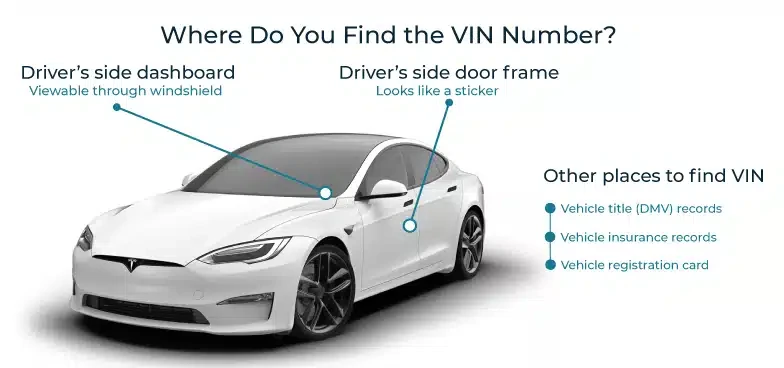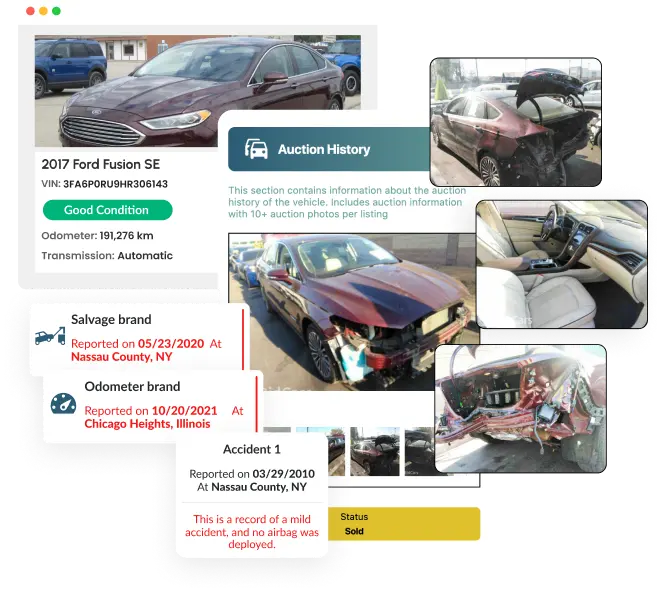Get Accurate Bericht zur Fahrzeughistorie
Get a vehicle history report for cars, motorcycles, trucks, and even classic cars. Access accident history, title brands, theft records, sales history, open recalls, and more to make informed decisions before a used car purchase or sale.
Möchten Sie mehr über die Merkmale, Optionen und Pakete der Fahrzeuge erfahren? Fensteraufkleber Lookup
What is a Vehicle History Report?
A vehicle history report is a detailed document that shows information about a vehicle’s past. The information shown in a report includes ownership history, accident records, damages, service and maintenance records, title brand records, theft records, and more. With these details easily accessible, car buyers and sellers can verify the actual condition of a used vehicle and make informed decisions.
What Are the Common Risks When Buying a Used Car?
Buying used cars always carries risk, especially if the seller doesn’t disclose the vehicle’s true condition and history. Some common risks are:
Hidden Damages
A vehicle might have been in a major crash or flood, leaving severe damage or corrosion. Without a full history check, such wrecks often go undetected.
Mechanical Problems
Some vehicles are listed for sale with engine problems, transmission issues, and electrical problems that are not easy to identify, leading to costly repairs down the road.
Title Fraud & Branded Titles
Sellers might “wash” or conceal a branded title (salvage, rebuilt, junk). For example, a “clean” title car can turn out to have been declared a total loss elsewhere.
Mileage Fraud
Some sellers fraudulently alter the odometer reading to make a car appear to have less wear and tear than it actually does. 450,000+ vehicles per year have rolled-back odometers.
Pending Loans or Even Stolen
The vehicle may have unpaid loans and may even be stolen, meaning the lender or the police could claim it after purchase at any time.
Undisclosed Recalls
Some used cars have open safety recalls that haven’t been fixed, posing serious risks. Sellers may not mention them unless asked.
Detailed Vehicle History Removes the Risks from Used Car Deals
Many car buyers miss damages, accidents, flood titles, salvage titles, theft records, and more. They end up not being able to verify the true condition of a vehicle. With our comprehensive vehicle history reports, they remain protected and can make the right choices.
Für Einkäufer
- Identify hidden damages before purchase
- Verify ownership and spot stolen records
- Be sure that a vehicle has been maintained properly
- Have better negotiations and get more value
- Spot scams and walk away from risky deals
- Avoid costly repairs after purchase

Für Verkäufer
- Be transparent with past records and have faster sales.
- Cars with history reports can sell for up to 15% more.
- Justify a car's asking price with accurate vehicle history.
- Providing a window sticker (factory options and MSRP) builds buyer trust.
- Make it easier for car buyers to compare several vehicles.
- Verify a vehicle’s value and condition before a trade-in.

What Information Is Included in a Vehicle History Report?
A vehicle history report shows everything that has happened in a vehicle's lifetime, including title records, accidents, odometer readings, ownership records, thefts, maintenance records, and more. Here’s what you can find in a vehicle history report:
Title Check Records
Do you know if that vehicle has a branded title? With our VIN check tool, you can check for salvage, rebuilt, junk, flood damage, fire brand, lemons, flood brand, and all other branded titles.
Accident and Damage Records
Wonder if the car has been in any accident or has damage reported throughout its life? See all accident records and severity of damages with a detailed vehicle history report.
Odometer Readings
With a detailed vehicle history report, you can verify the mileage reading on the odometer at different points in time and check if it has been tampered with before sale.
Aufzeichnungen über das Eigentum
Personal car? Taxi? Rental? Multiple owners? Find out the vehicle usage history of your vehicle as well as the previous number of owners, location of owners, and duration of the ownership.
Rückrufe
Informieren Sie sich über Rückrufaktionen des Herstellers oder der NHTSA und stellen Sie sicher, dass ein Fahrzeug in verkehrssicherem Zustand ist oder nicht.
Gestohlene Aufzeichnungen
Do you know if a vehicle has stolen records? A report shows if a vehicle was stolen in the past and if it was recovered. Avoid getting legal charges and losing your car and money.
Service- und Wartungsaufzeichnungen
See if the used vehicle has been serviced and maintained properly in the past. Be sure it’s in great condition before payment.
Pfandrecht und Darlehensaufzeichnungen
Verify if the vehicle you are interested in has no lien or loan records that may affect you after purchasing any vehicle you are interested in.
Auction & Sales History with Photos
Our vehicle history report shows if a car has been through auctions and its condition with photos. You can also see its full sales history—when, where, how many times it was listed, and at what price—along with images when available.
Get More than just History Reports!
We provide more than just vehicle history reports! With our suite of tools, car buyers and sellers can easily learn everything they need to know about any vehicle and make informed decisions.:
Original Window Sticker by VIN
Instantly get the factory window sticker by VIN and view the car’s original MSRP, color, standard features, options, fuel economy, warranty, and more.
Baupläne für klassische Fahrzeuge
You can get build sheets by VIN for classic or vintage vehicles with our build sheet lookup tool for classic vehicles. View build specs, features, color, pricing & more.
What You’ll Gain with Detailed Vehicle History Reports
Using Detailed Vehicle History reports gives you full control of the used car purchase or sale and better bargaining power. Here’s what you can expect with our reports:
Avoid Costly Surprises
Know about past accidents, title brands, or flood damage in advance with our data. It can save you thousands on repairs; one user noted missing Carfax info that we caught.
Negotiate Better
Leverage the report’s details to haggle a lower price or justify your offer. (Sellers even use our reports to justify higher asking prices when their cars are clean.)
Protect Yourself
Avoid legal headaches from title fraud or undisclosed damage. A vehicle history report is accepted proof of a vehicle’s true history in most transactions.
Make Smarter Investments
Spot high-risk vehicles before purchase and invest in cars that retain their value for a long time. Our vehicle history reports help you identify reliable vehicles.
Get Your Vehicle History Report in 3 Easy Steps!
Eine Fahrzeugbericht nach VIN is a breeze! Just enter the VIN to access car facts, including accident history and more.
Schritt 1: Geben Sie Ihre VIN ein
Provide the VIN to begin the process or search by US license plate number.
Step 2: Submit The Form
Click “Search VIN” to submit the form and start your instant search.
Step 3: Receive Your Report
Make the necessary payment to access a detailed and easy-to-read vehicle history report.
That’s it! No phone calls or paperwork. We give you all the vehicle information you need with just a few clicks.
Why We Are the Best Choice: A Comparison with Competitors
Unsere Berichte zur Fahrzeughistorie sind der Konkurrenz weit voraus. Erhalten Sie mehr Informationen über JEDES Fahrzeug aus JEDEM Land, komplett mit Auktions- und Verkaufsfotos - und das zu einem Bruchteil der Kosten anderer.
Unschlagbare Preise
Wir bieten die niedrigsten Preise in der Branche! Während Carfax und AutoCheck ein Vermögen verlangen, halten wir Geschichtsberichte 100% erschwinglich.
Exklusive Verkaufsdaten
Finden Sie die Autohistorie und sehen Sie sich über 70 Millionen einzigartige Verkaufsdaten an - Daten, die Sie sonst nirgendwo finden. Treffen Sie fundierte Entscheidungen mit Vertrauen!
Weltweite VIN-Abdeckung
Unser Tool zur Abfrage der Fahrzeughistorie deckt VINs aus der ganzen Welt ab und ermöglicht Ihnen den Zugang zu Fahrzeughistorien, die andere Wettbewerber nicht bieten können.
Auktionsprotokolle, die alles enthüllen
Wenn ein Fahrzeug eine Auktion durchlaufen hat, haben wir die Details! Von den Verkaufspreisen bis zu Schäden und bis zu 10 Fotos - wir bieten Ihnen die Insiderinformationen, die Sie brauchen.
|
Merkmal
Preis
|
Carfax
$44.99
|
DVH
$19.99
|
Autocheck
$29.99
|
|---|---|---|---|
| Verkaufsliste mit Fotos | |||
| Auktionsberichte mit Fotos | |||
| Daten zum Marktwert | |||
| Detaillierte Fahrzeugdaten | Begrenzt | Begrenzt | |
| Fensteraufkleber | |||
| Unterstützung für klassische Fahrzeuge | |||
| Empfehlung zur Wartung | |||
| Geschichte der Eigentümerschaft | |||
| Unfallgeschichte | |||
| Prüfung der Beschädigung | |||
| Prüfung des Markentitels | |||
| Prüfung des Bergungsanspruchs | |||
| Karte der Eigentumsverhältnisse | |||
| Rückrufe | |||
| Halterungen für schwere Lastwagen, ATVs, Anhänger und Motorräder | |||
| Mobile und Desktop-Anwendungen | Begrenzt |
Vehicle History Report for All Vehicle Types
Wir bieten Berichte für alle Fahrzeugtypen an, von Fahrzeugen, die nach 1981 hergestellt wurden, bis hin zu Oldtimer-Historienprüfungen, und erstellen detaillierte Berichte für Motorräder, Lastwagen, Anhänger, Wohnmobile und mehr.
Klassische Autos
Musterbericht anzeigenThis classic car has a branded title, one accident, two damage records, and two auction records.
Motorräder
Musterbericht anzeigenThis motorcycle has a branded title, a mileage discrepancy, one accident with damage, two lien or loan records, four event reports, and was previously listed for sale online.
This ATV has a title brand record, damage records, auction records, sales records, and two lien or loan records.
Heavy-Duty Trucks
Musterbericht anzeigenThis truck has a branded title, one accident with damage, 13 open recalls, two lien or loan records, two event reports, and one auction record.
This RV has a branded title, one damage record, one lien or loan record, two event reports, and one auction record.
Anhänger
Musterbericht anzeigenThis trailer has a branded title, three accidents, two damage records, one lien or loan record, and one event report.
Avoid Costly Mistakes – Holen Sie sich Ihren Fahrzeughistorienbericht Now!
Don’t drive off wondering what’s under the hood. With a vehicle history report, you’ll know a car’s story before you commit. Start your vehicle background check now and shop with confidence.
Get Popular Vehicle History Report by Manufacturer
Get Popular Vehicle History Report by Country
Get Popular Window Sticker Report by Manufacturer
Get Popular Motorcycle History Report Information by Manufacturer
Get Build Sheet by Manufacturer
Get a Vehicle History Report by License Plate in Any U.S. State
Aktuelles aus unserem Blog
Stay updated with the latest guides, tips, and news about vehicle ownership, buying and selling safely, and vehicle history.

Wie man die Autohistorie online überprüft
Understanding the history of a used car is priceless, it helps to know if investing in a particular used vehicle is worthwhile.
Mehr lesen '
So entschlüsseln Sie eine 13-stellige VIN
In diesem Artikel zeigen wir Ihnen, wie Sie eine 13-stellige VIN mit Hilfe unseres 13-stelligen VIN-Decoders entschlüsseln können.
Mehr lesen '
Vollständige Liste der Ländercodes der VIN-Nummern
VINs identifizieren Fahrzeuge weltweit, einschließlich Herkunftsort, Werk und fahrzeugspezifischer Herstellungsdetails.
Mehr lesen 'FAQ About Vehicle History Report
A Vehicle Identification Number (VIN) is a unique 17-character code assigned to every vehicle. It serves as the vehicle's fingerprint, providing essential information about its make, model, year, and manufacturing details.









